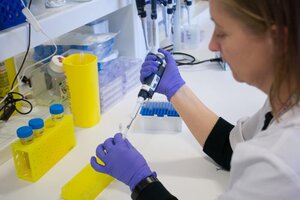Survival rate of high-risk neuroblastoma patients treated with next-generation immunotherapy at SJD Barcelona Children's Hospital
Researchers of SJD Barcelona Children's Hospital and of Institut de Recerca Sant Joan de Déu (IRSJD) have published the results of treatment with the humanised anti-GD2 antibody Naxitamab (DanyelzaR) combined with granulocyte-macrophage colony-stimulating factor (GM-CSF; LeukineR) in high-risk neuroblastoma patients in full remission after induction therapy (chemotherapy and surgery), demonstrating an overall survival (OS) at 3 years of over 90%.
Neuroblastoma is the most frequent tumour in the first 5 years of life. It originates in the autonomic (sympathetic) nervous system and shows a highly variable prognosis, depending on the molecular characteristics of each subgroup. The long-term high-risk neuroblastoma survival rate in the best centres is no more than 55%.
While at present the cure of high-risk neuroblastoma continues to be one of the major challenges faced by childhood oncology specialists, the development of next-generation anti-GD2 immunotherapy has succeeded in breaking through what had been impenetrable barriers, allowing the long-term survival of relapsing patients or those with a refractory disease, something that had previously been impossible.
"Using immunotherapy, we teach the patient's immune system to recognise and eliminate the neuroblastoma cells ‒ real experts at evading the immunosurveillance system, meaning that the tumour will have less chance of success when it tries to reactivate itself", says Dr Jaume Mora, scientific director of the Pediatric Cancer Center Barcelona and coordinator of the IRSJD Paediatric Cancer programme.
For the first time worldwide, on 12 June 2017, at SJD Barcelona Children's Hospital, Naxitamab was administered in combination with GM-CSF to a patient with high-risk neuroblastoma. Over the course of 4 years, over 200 patients from around the world have been treated by this method and SJD Barcelona Children's Hospital has become the only centre outside the USA to provide this treatment.
"Now, on the basis of the results obtained over all these years, we have verified that the overall survival of high-risk neuroblastoma patients in first complete remission is over 90% at 3 years. And even more importantly, we have achieved this survival eradicating high-dose chemotherapy and autologous transplantation from the treatment plan of these patients when they are treated with Naxitamab and GM-CSF", explains Dr Jaume Mora.
The results, which have been published in Cancers; Frontiers in Pharmacology and Pediatric Blood Cancer, are the outcome of over 10 years of work focused on demonstrating that immunotherapy, when combined with the most effective chemotherapy, surgery and radiotherapy strategies, allows the cure of a significantly higher number of cancer patients.
In December 2020, the FDA approved Naxitamab for the treatment of high-risk neuroblastoma in patients with refractory bone marrow or bone disease. Less than 4 years had elapsed from the start of the trials to the approval by the regulatory agency, marking an unprecedented success in the long hard path of approving a drug for rare diseases. Half of the patients documented in the trial which led to the approval of Naxitamab were treated at SJD Barcelona Children's Hospital, reflecting once again Paediatric Cancer programme's world-class pioneering endeavours in this field.
"Up to now, many patients with relapsing high-risk neuroblastoma no longer responded to the usual treatments: chemotherapy, radiotherapy, etc. But with the results of our clinical trial, we have demonstrated that treatment with next-generation immunotherapy offers a possible cure, so we should keep researching in this direction and continue to observe the evolution of these patients in the long term", concludes Dr Jaume Mora.
References
Mora J, Castañeda A, Gorostegui M, Santa-María V, Garraus M, Muñoz JP, Varo A, Perez-Jaume S, Mañe S. Naxitamab combined with granulocyte-macrophage colony-stimulating factor as consolidation for high-risk neuroblastoma patients in complete remission. Pediatr Blood Cancer. 2021 May 22:e29121. doi: 10.1002/pbc.29121. Epub ahead of print. PMID: 34022112.
Mora J, Castañeda A, Colombo MC, Gorostegui M, Gomez F, Mañe S, Santa-Maria V, Garraus M, Macias N, Perez-Jaume S, Muñoz O, Muñoz JP, Barber I, Suñol M. Clinical and Pathological Evidence of Anti-GD2 Immunotherapy Induced Differentiation in Relapsed/Refractory High-Risk Neuroblastoma. Cancers (Basel). 2021 Mar 12;13(6):1264. doi: 10.3390/cancers13061264. PMID: 33809255; PMCID: PMC7998131.
Mora J, Castañeda A, Flores MA, Santa-María V, Garraus M, Gorostegui M, Simao M, Perez-Jaume S, Mañe S. The Role of Autologous Stem-Cell Transplantation in High-Risk Neuroblastoma Consolidated by anti-GD2 Immunotherapy. Results of Two Consecutive Studies. Front Pharmacol. 2020 Oct 30;11:575009. doi: 10.3389/fphar.2020.575009. PMID: 33324208; PMCID: PMC7723438.

We have demonstrated that treatment with next-generation immunotherapy offers a possible cure, so we should keep researching.
